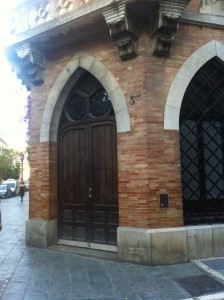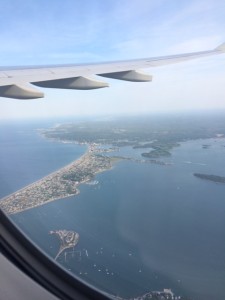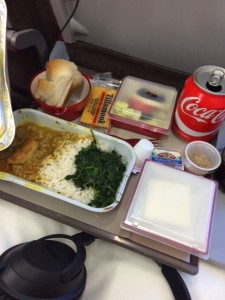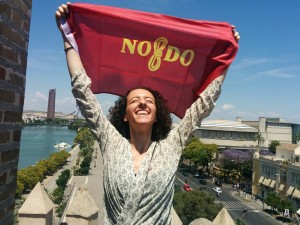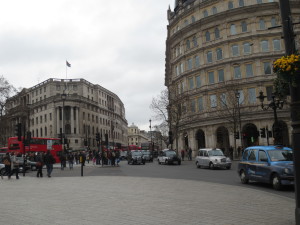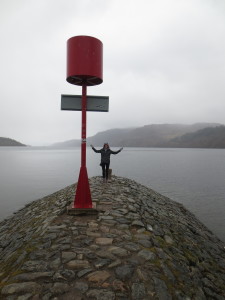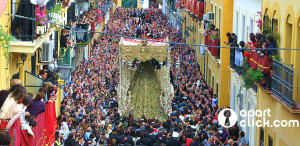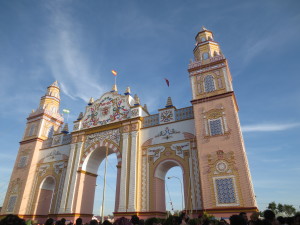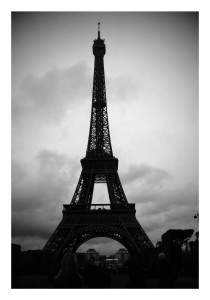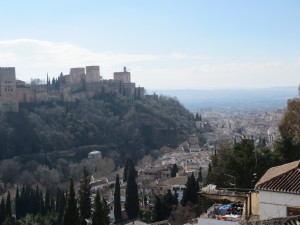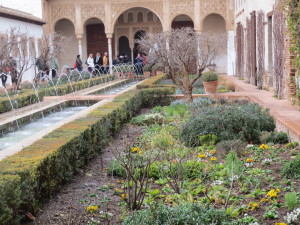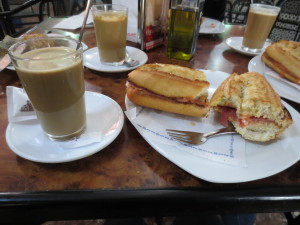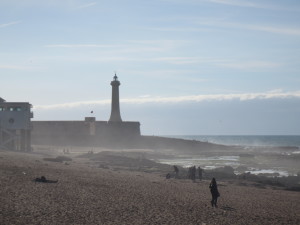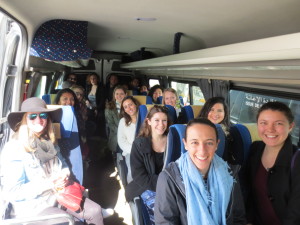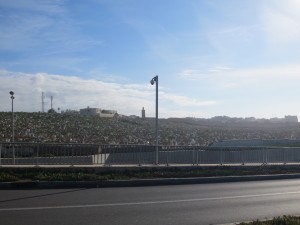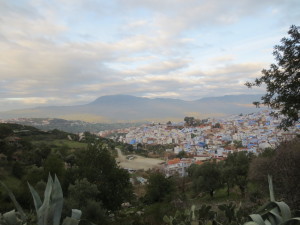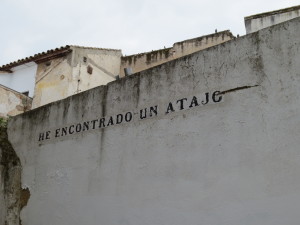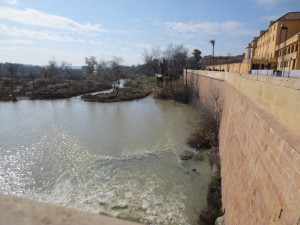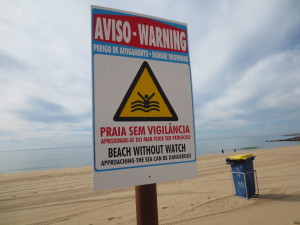As I began this post, I was 30,000 feet in the air, somewhere between Zurich and Madrid (EDIT: Looking back, I realized that I was on this flight during the time that the Germanwings flight crashed. Scary!). I was on my way back to Seville after having spent the weekend with my dad in Hamburg, Germany, where he was visiting for work. Lucky for me I got to see him on my birthday (which was the day I started this post!) and was able to celebrate by eating lots of meat (mostly sausage) and drinking a fair amount of German beer. This past weekend, I headed into London to visit a friend and to see the city a bit. Then I went up to Scotland to see another friend, and I stayed there through Wednesday. Though I will admit that I skipped classes to see my dad in Germany, I won’t have to miss this week because we are celebrating “Semana Santa,” or Holy Week, in Seville. I came back yesterday in order to see the processions, or “pasos,” that make Seville so famous for its pre-Easter celebrations. This will include my host mom and I getting up at 5:00 AM tomorrow in order to go into the center and see the holiest (?) of all of the pasos, La Madrugada (“the dawn”), which begins its march in the wee hours of Viernes Santo–Good Friday.

One of the two official beer-and-meat 21st birthday meals.
But I’ll save my Semana Santa and UK experiences for the next post (or the one after that). Today, because I am realizing how little time I’ll spend in Seville over the next two weeks, I want to tell you about my life in the city where I am studying and give you a taste of the day-to-day. I’ve been keeping a running list of some of the things I think you’ll find most interesting in my handy dandy notebook (credit: Blue’s Clues) which is sitting beside my computer. Note: I include here a significant number of tangents about European life/things that made me laugh/other miscellaneous and not directly related details. But, as always, I hope you enjoy regardless.
NOTE: I apologize in advance for the lack of pictures in this post. For some reason, the photo uploader on sites.psu isn’t working too quickly tonight.
Daily/Weekly Routine
This seems like a good place to start! Thankfully our program does not offer any classes that begin before 9AM, and even more thankfully I was lucky enough to have all of my classes start at 10:30. I wake up around 8:15 so I can shower and eat before I leave at 9:30. My host mom is such a sweetheart and always has my breakfast materials (which I will tell you about in the next section) laid out for me at my spot on the table. This “spot” is arbitrary and subject to random changes, as I learned quickly over the first few weeks of my stay. During breakfast and dinner, I sit at one of the heads of the rectangular table. But during lunch, I sit at one of the long edges next to my host mom, who may or may not join me for breakfast or dinner. It depends on the day. Lunch, however, we always eat together, and when my host dad knocks on my door and asks me if I want to help him “poner la mesa” (set the table), I know it’s almost time to eat. Again, food info is coming in the next section.
I walk to a nearby bus stop with some friends from my program who also have 10:30 classes. Originally, our orientation guide introduced us to the Metro–the equivalent of a subway–to get to the university, but we discovered that the bus station is closer to our apartments and also costs less per ride. So we bus ourselves into Universidad Pablo de Olavide each day. I am taking just four classes this semester: Spanish literature, Spanish language, global economics, and intercultural communications. For the most part, these classes are okay. The Spanish teaching style is difficult to adjust to, particularly because:
- Several of the professors, who are native Spanish speakers but teach courses in English, tend to have trouble expressing themselves in their second language. This makes discussion, as well as getting our questions answered, difficult.
- It often seems like professors are trying to “cater” to the American, discussion-based class style, but have difficulty maintaining these discussions because they have not practiced enough (or so it seems to us) and also perhaps because they don’t understand everything we are saying.
All in all I am not thrilled with my classes here. This could also be partly due to the fact that I have found my niche in the English program at Penn State and am thriving under the guidance of our wonderful department. But, if nothing else, it has been nice to take a break from the sometimes rigorous book-reading and paper-writing. I’ll have my fill of that over the summer and next year.
I have class until 2 or 3 in the afternoon, at which time I come home for lunch. For those who don’t know, Spanish people tend to eat very late (it sometimes borders on 3:30 for my host family), and lunch usually lasts a while. I am typically eating and talking with my family for one to two hours during lunchtime. I really enjoy everything about the meal, though it can be exhausting to keep up with the conversation and to pay attention to the television (which is on during all of our meals). For this reason, I take a little “descanso” or “siesta” (rest/nap) after lunch. I don’t usually sleep, but I like to relax in a sunny spot in my room for an hour or so.
At this point, my day can take one of many turns. Sometimes, I’ll take a run with a friend to Parque Maria Luisa, which is situated next to La Plaza de Espana (if you Google “Sevilla,” the Plaza de Espana will be one of the first images to show up). Some nights I’ll meet up with my “intercambio”–a language exchange partner who wants to practice English just like I want to practice Spanish. We go, for example, to get tapas and a drink, or walk around, and take turns speaking each language. Recently, she won us movie ticket vouchers! So we’ll be doing that sometime soon.
Once a week, I volunteer at a “colegio,” which in this case is a private, religious primary school which educates kids between the ages of 3 and 14. I help out with a group of 7-8 year olds, which has been really fun so far. To be honest I feel like I don’t do too much while I am there besides laugh at the funny things the kids do and every once in a while I help out with a little activity. Unfortunately I have missed the last two weeks, the first because I got drenched on my way there during a chaparron (a downpour) and this past week because I was in Germany visiting my dad. And next week the kids don’t have school because it is Semana Santa! So it will be a while before I visit the colegio again.
The afternoons are also good for heading to a cafe to do some homework or for taking a walk to the center of Seville. Otherwise, it can be nice to stay in for the night, especially after traveling over the weekends. I will usually finish up homework, write this blog, or e-mail friends and family before dinner. Between 9PM and 10PM, I wait for my host mom’s knock on my door: “Ana. Cena.” Anna, dinner! I head into the family room to sit with my host parents for dinner and usually end up staying for an hour to an hour and a half. Then I go to bed!
Food
I may have already posted about food before, but that was pretty early on and Anna from 2 months ago had no idea that she would like as many Spanish foods as she does now. Of course, I liked breakfast from the start. I usually have two pieces of toast and put on top of them whatever my host mom sets out for me. At first, it was butter and jelly. I didn’t realize that people put butter and jelly on the same slice, so I would cover one piece with butter and one with jelly. That is, until my host mom subtlely suggested, “Anna, Noelia (my host sister) likes to eat her toast with butter and jelly on the same piece.” I got the hint and it’s actually really good! Other breakfast combos: cream cheese and jelly (even better than butter and jelly), a tomato/cream cheese paste with turkey, chocolate-filled croissants (another favorite). Alongside my eatables, I have a glass of hot milk, to which I add either cafe cappucino (a powder which makes a sweet cappucino/latte type thing) or Cola Cao, which is the Spanish equivalent of something like Nestle or Ovaltine.
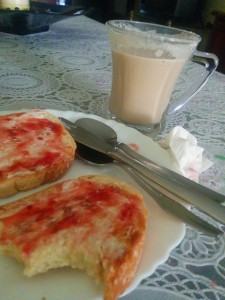
my usual view in the morning. recently my host mom let me pick out a new flavor of jelly!
Lunch here, not breakfast, is the most important meal of the day. It is certainly the biggest, and because of that I am usually stuffed to the point of not moving for at least 20 minutes after the meal has ended. I would say our most frequent dishes are soups and fish platters. The soups are either creamy (usually cream of some type of vegetable) or those filled with beans (garbanzo, lentils) and a wide variety of vegetables. I have learned to LOVE lentils, even though I did not like them at all before leaving. My host mom usually adds some chorizo picante, or spicy sausage, to the lentil mixture. I am truly upset now that the winter is over (which is weird for me) because Sevillians tend, logically, to not eat hot soups when it is 110 degrees outside. The lentil days are numbered.
As far as fish, we have had what seems like every type imaginable. Bacalao, sardines…I really don’t know the names of all of the fish. My host mom always tells me “We’re having this fish today,” and then waits for me to react, because we have usually had that type of fish before. But I can’t keep all the names straight and they all taste similar anyway. It is crazy to me that 1) my host family eats the eyes, head, and tail of many types of fish and 2) that I usually have to remove the spines of the fish I eat. I am not used to either of these things, though having been here for close to three months now I am growing accustomed to having to do it. I am still not the biggest fan of fish but I need some protein in my life and being so close to the sea, it is a staple in many (most) Spanish homes.
We eat other things besides soup and fish. Several times, my host mom has made a pasta bolognesa dish, which I absolutely adore. This is the only lunch food that I finish before my host parents do. Sometimes we have fried eggs and vegetables; sometimes we have chicken and french fries. We always, always, always have bread, whether it is in typical roll form or in the form of “pico,” which are tiny crunchy breadsticks that I would probably refer to as crackers in the United States. We’ll often have “salad,” which can either be a traditional salad with lettuce, shredded carrots, corn kernels, and vinegar dressing, or which can also be simply a whole tomato sliced up and topped with vinegar and some seasoning. Tomatos are another food I didn’t like before coming here, and now they are the first thing I eat when I sit down.
After our salad and main course, we dig into a side dish that my host mom has prepared. Many times these are empanadas, which are like small, fried dumplings filled with some type of meat or fish (for example, chicken or tuna). Now that I think about it, this side dish is usually a fried food, whether it is an empanada or just plain old fried fish. And after this, we all usually have a piece of fruit. During my first few weeks here, oranges were the fruit of choice, and especially mandarinos, which are the perfect size orange and are easy to peel. In January, I was eating 2 oranges per day because they were so plentiful and because I liked them so much. Now, since oranges are going slightly out of season, they are harder to peel and not as sweet. So, instead, we eat bananas, pears, and apples, with the rare strawberry thrown in there. After the fruit, lunch is finally over, though my host parents usually have tea or coffee afterwards, extending lunch/the post-lunch siesta by another hour.
Dinner is a less extravagant affair. Many times my host parents themselves do not even eat dinner because they are full from eating little snacks throughout the rest of the day. Through March, when it was still “cold” outside, we would always have soup. This is usually just hot water with a packet of some kind of stir-in soup/pasta. At the beginning they would make fun of me because I couldn’t eat the soup while it was just out of the microwave. “You eat so strangely,” my host dad said to me once. “You take little bites of everything and you don’t eat the soup while it’s hot!” Actually, Fernando, when I try to sip the hot soup it burns my tongue and mouth, so I have to eat everything else before it. (I really am doing well with my host family.) My host parents will also have a piece of fruit, and my host mom will give me my own portion of whatever fruit they are having. Then she will also make me something else: eggs and sausages (which look exactly like hot dogs but taste better), microwave pizza (bocapizza), a piece of fish, a bocadillo. The other week she made me 4 spring rolls and chips. It was fantastic.
There have been a few awkward situations where I have to tell them that I don’t like certain foods. One of the first of these was a plate called callos. I remember being really hungry the day Rosa served it, and I also remember her explaining to me that she thought I would like it a lot. So it was with eagerness that I dug into lunch and started forking the callos into my mouth. About 3 bites in, I realized that the stuff had a weird texture and was a little chewy. Two bites later I was no longer hungry because I kept thinking about how the callos looked like cow skin. I am not a vegetarian and this was one of the first instances in my life when the reality of what was sitting in front of me–a dead animal–became overwhelming. After not eating it for 10 minutes I apologized and told Rosa I couldn’t eat it. She asked why, and my host sister said, “Because she doesn’t like it!” Bluntly put, but Noelia hit the mark. Later, I looked up callos on Wikipedia: its English equivalent, tripe, is “a type of edible offal from the stomachs of various farm animals.” I made it clear that I absolutely cannot have this dish again.
Also famous in Spain are olives, which I have learned that I hate. I was pretty much indifferent to them before arriving in Spain, though I rarely ate them. That probably explains the indifference. I can’t remember where I first tried olives here, but I have developed a strong aversion to them. This is unfortunate because my host family loves olives, and they love to buy different kinds and to have me try them in case I end up liking one of them. My host dad will prompt me: “Pruebalo!” Try it! I say, “No, Fernando, I really don’t like olives.” Then my host mom will chime in: “No, but these are different than the other ones. You will like them.” I look at them for a minute before reluctantly plucking one from the bowl. I even more reluctantly put it into my mouth, and then try to chew and swallow it as fast as possible. They make my head hurt and I usually grab some bread to get the taste out of my mouth. The most recent kind they had me try was filled with anchovies. They were surprised when I didn’t like it. I wasn’t. I went through a week or so when my host mom was making me bocadillos with mortadello, or olive loaf, which in short is a type of ham that is ruined by the olives that are interspersed throughout it. I had to claim that it was upsetting my stomach, which it really was.
I do actually like a lot of the food that my host mom cooks, and one time after I told her that, she gave me the name of the blog where she gets many of her recipes from. It is called Cometelo, which in Spanish means “Eat it yourself.” All of the recipes are in Spanish, but don’t forget that you conveniently have a translator (aka, the writer of this blog) if you see anything you like and want to understand what it is saying. That will be the true test of my fluency.
Miscellaneous things
Here are some random details about my life that I thought you might find interesting!
- When I first got here, Sam Smith’s “Stay With Me” was the theme song for practically every Spanish soap opera I saw advertised.
- Most of my peers’ homestays (including mine) do not have printers. Instead, we have to go to a local copisteria or papeleria, where we pay on average 10 cents per sheet printed.
- While it is usually warm year-round, days when it is cloudy, cool, or rainy hold up the laundry process. All clothes are line-dried here, so if you need something to be clean/dry and it is cool or rainy, you are out of luck.
- The other day, my host parents sent me a short video of Sevilla via WhatsApp, which my host mom had me watch three times in one sitting. She kept asking me if I could understand the music lyrics, and I told her I needed to listen more carefully. She would restart the video, and then talk her way through it, so I could never hear the words enough to understand them. About the video, my host mom said when I show it to my American friends, “Van a flipar.” They are going to…flip? I looked up “flipar” and it doesn’t translate, so I’m assuming they take influence from English. I thought it was the funniest thing in the world. (I’ll be sure to show you this video.)
- Speaking of language, my host dad told me the other day that his foot was “dormido.” I asked him to clarify once or twice before realizing that they use the exact same expression in Spanish that we do in English to describe the phenomenon of their limbs being “asleep.” It doesn’t sound like it would be a revelation, but it took me a few seconds to figure it out.
Well, this post ended up having only three sections, and what I have learned from the Spanish people so far, I am not surprised that these sections mainly consist of me talking about socializing and eating. That is what life seems to be about here, and I’m not complaining. Join me next time for another adventure (expect some news about Semana Santa!).
Location: Seville, Spain



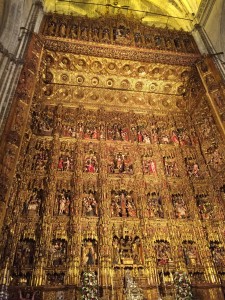
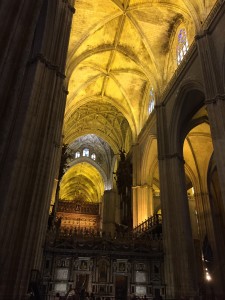
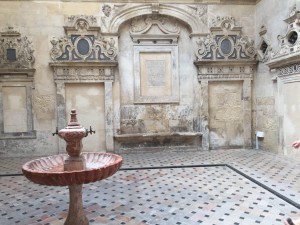
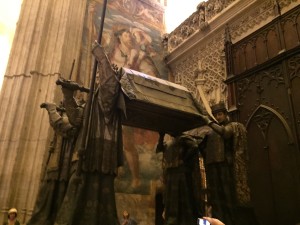
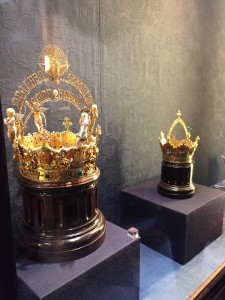
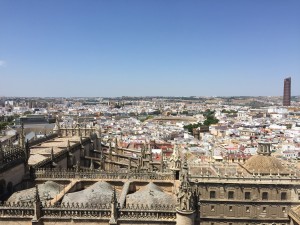
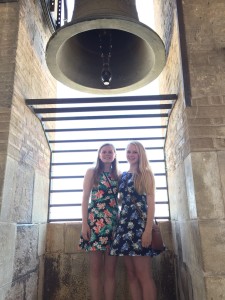
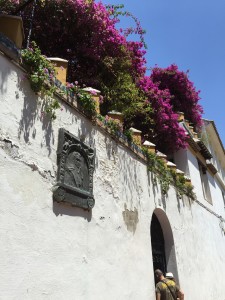
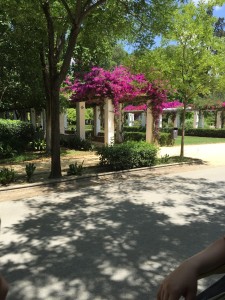
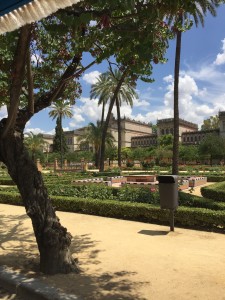

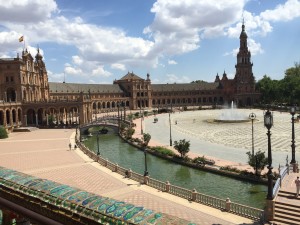
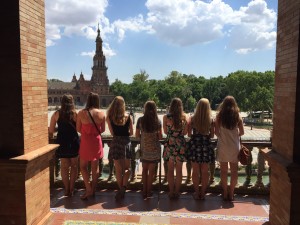
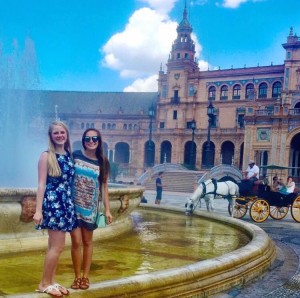
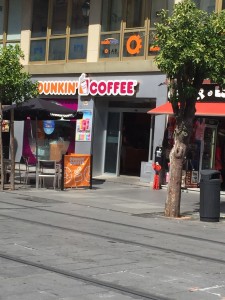
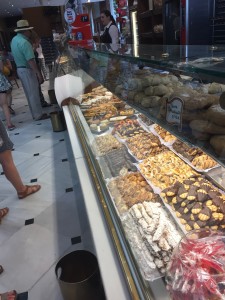

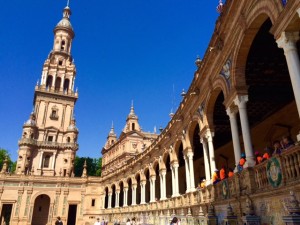

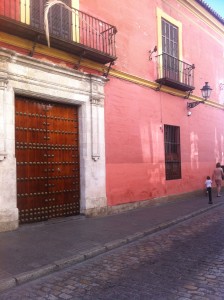 One of the many unique, wooden doors in Seville. If you look closely, you might be able to see where the smaller door is within the large door.
One of the many unique, wooden doors in Seville. If you look closely, you might be able to see where the smaller door is within the large door.